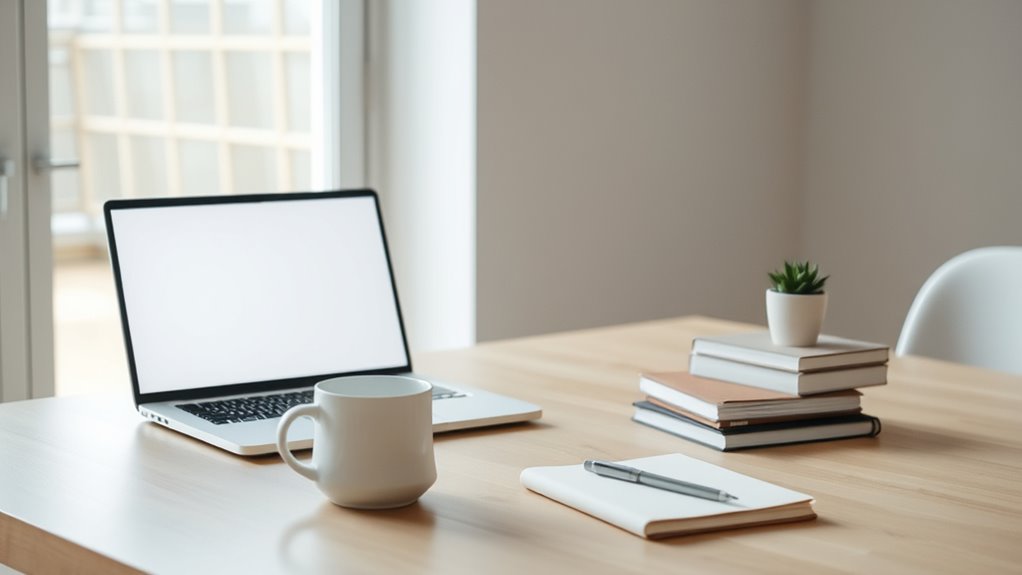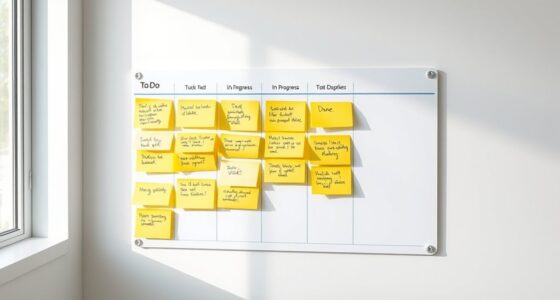To declutter your online life, focus on simplifying your digital tools by limiting apps, accounts, and notifications, and organizing your files. Set clear boundaries for screen time and establish tech-free zones to reconnect with offline activities. Prioritize meaningful interactions and disconnect regularly to reduce stress and mental overload. Protect your privacy by updating security settings and using encryption tools. Embracing these minimalist habits can transform your digital experience—exploring these steps further will help you create a more focused, secure, and balanced online presence.
Key Takeaways
- Limit digital clutter by consolidating essential apps, tools, and online accounts to reduce distractions and increase focus.
- Set intentional boundaries for screen time, notifications, and online activities aligned with personal goals.
- Organize digital files, emails, and device storage through consistent naming, folder structures, and regular cleanup.
- Create tech-free zones and designated offline times to foster real-world connections and mental clarity.
- Regularly assess digital habits, monitor device use, and adjust boundaries to maintain a minimalist and purposeful online life.
Understanding the Core Principles of Digital Minimalism
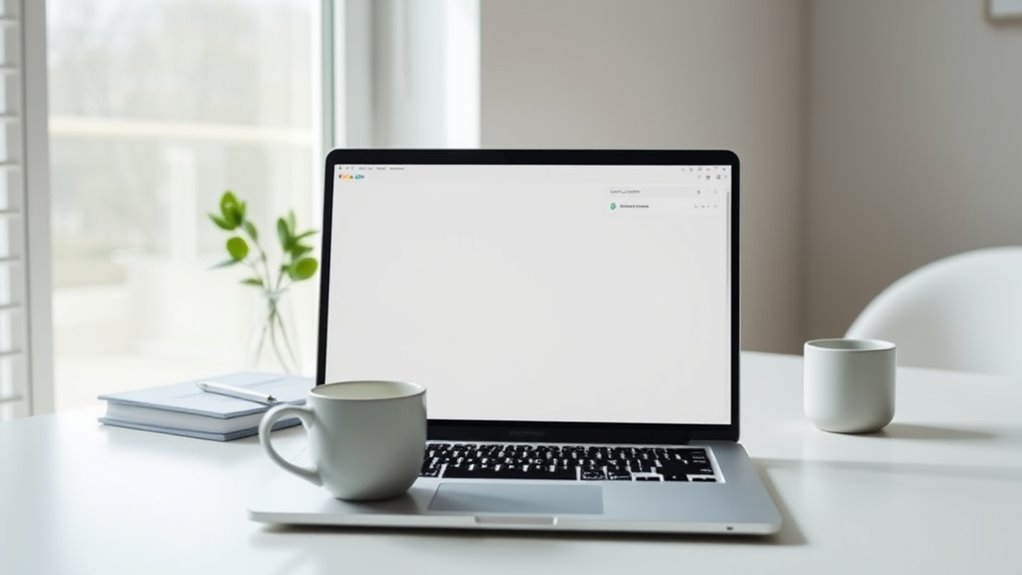
Understanding the core principles of digital minimalism is essential for transforming your digital habits. First, recognize that clutter is costly—excess digital devices, apps, and services waste your time and attention, pulling you away from meaningful activities. This overload can lead to overwhelm and decreased productivity, so limiting digital clutter helps you reclaim focus. Next, optimization matters; choose a small set of tools that truly support your values and plan their use carefully to avoid diminishing returns. Be intentional with your digital activities—align them with your goals and purpose, rather than acting on impulse. Focus on high-value tasks instead of passive consumption, and establish clear rules for technology use. These principles help you create a sustainable, fulfilling digital life aligned with what truly matters to you. Additionally, understanding the importance of content quality can help you prioritize information that genuinely enriches your knowledge and well-being. Developing an awareness of digital overload can further support your efforts to maintain a healthy digital environment. Recognizing the impact of content overload on your mental clarity can motivate you to curate your online experience more intentionally and be mindful of screen time to prevent burnout. Incorporating awareness of device compatibility also ensures your digital tools function seamlessly, reducing frustration and distraction, thus supporting your goal of digital minimalism.
Recognizing the Signs of Digital Overload
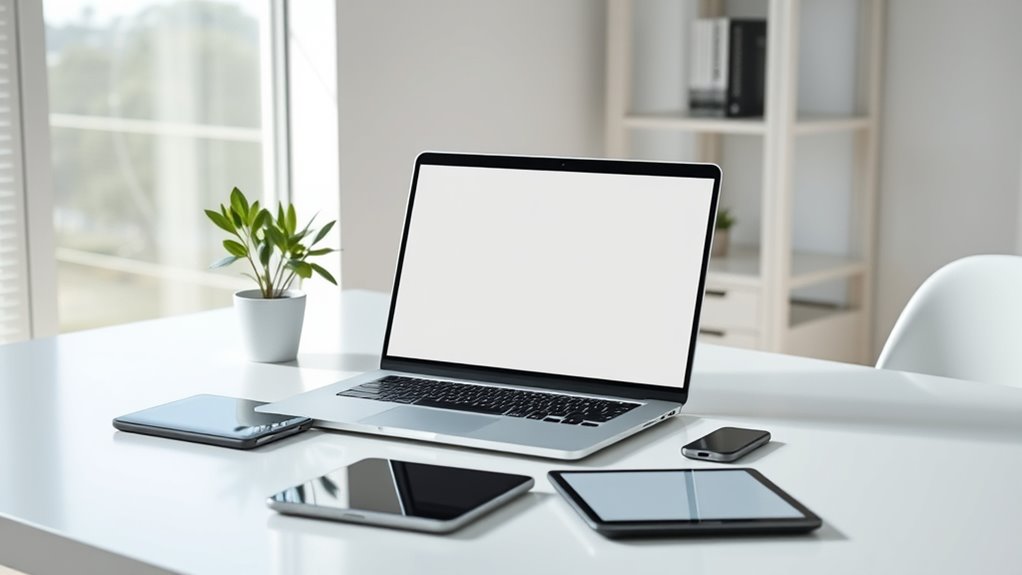
Digital overload doesn’t always announce itself clearly, but recognizing its signs is essential for regaining control. You might feel mentally drained, with difficulty concentrating or thinking clearly. Increased irritability, anxiety, and mood swings could signal cognitive exhaustion. Notice if you’re constantly distracted or struggling to filter information, reducing your efficiency. Decision fatigue may make even simple choices feel overwhelming, and your attention span could shorten from overstimulation. Physically, eye strain, headaches, muscle aches, and sleep issues become common. Emotionally, you might experience anxiety, FOMO, burnout, or mood swings. Behaviorally, you could notice increased distractibility, compulsive device checks, withdrawal from offline interactions, or procrastination. Recognizing these signs early helps you address digital overload before it escalates into more serious burnout. Additionally, implementing tools like screen time management can help you monitor and limit your digital consumption effectively. Developing awareness of relationship dynamics can also improve your overall mental health and online interactions. Being aware of the impact of digital overload enables you to adopt healthier online habits and regain your focus and well-being. For example, understanding the side effects of juice detox can remind you of the importance of moderation and balance in your lifestyle choices. Incorporating essential oils for mental clarity, such as peppermint or lavender, can also support your efforts to reduce stress and improve focus during digital detox periods.
Benefits of Embracing a Minimalist Digital Lifestyle
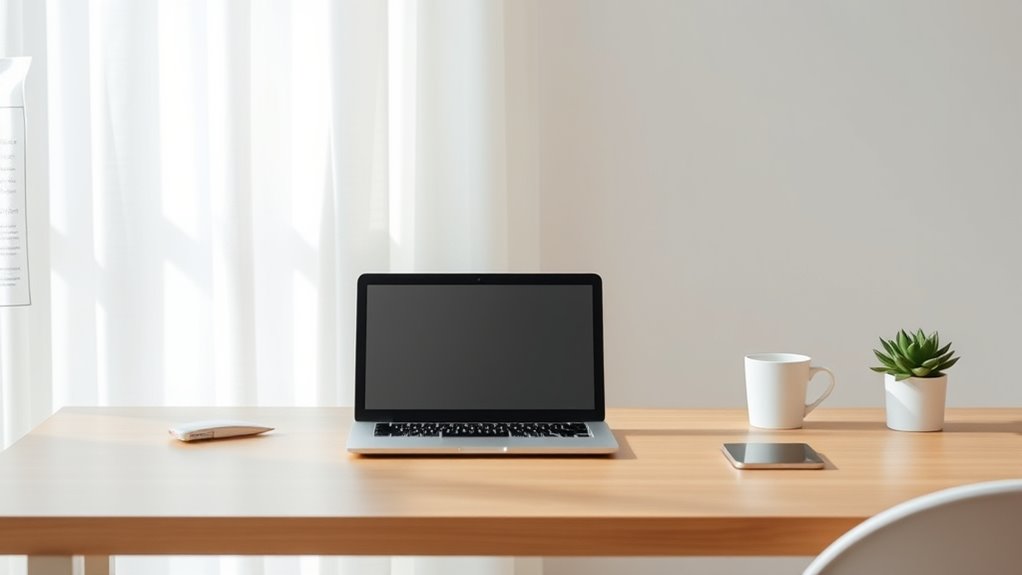
Embracing a minimalist digital lifestyle offers numerous benefits that can transform your mental, physical, and emotional well-being. By reducing digital distractions, you’ll experience less stress and anxiety, gaining mental clarity and a greater sense of balance. Limiting exposure to negative online content helps improve emotional regulation, fostering mindfulness and a stronger sense of community. You’ll sleep better by cutting screen time before bed. Enhanced focus and productivity follow as you channel energy into meaningful tasks and outdoor activities, boosting your sense of achievement. Additionally, fewer online accounts and shared data reduce privacy risks and digital threats. This lifestyle also encourages self-reflection, creativity, and discovering new passions. As a result, you’ll build deeper, more genuine social connections and strengthen your ties to local communities. Understanding privacy risks and how to manage cookies can further protect your personal information online. Practicing digital decluttering can help you streamline your online presence and eliminate unnecessary digital clutter, leading to a more focused and intentional digital life. Incorporating knowledge about cookie categories can help you make informed choices about your privacy and online security.
Practical Steps to Reduce Digital Clutter

Reducing digital clutter begins with taking intentional steps to organize and streamline your online environment. Start by cleaning your digital files—use consistent naming conventions, organize files into clear folders, and delete duplicates with specialized tools. Regularly review your cloud storage, removing unnecessary items and archiving seldom-used files. Manage your email by applying the “Inbox Zero” method, unsubscribing from unwanted newsletters, and setting up filters for automatic organization. Clear your desktop of excess icons, grouping related files into folders with descriptive names, and uninstall unused apps to boost device performance. Additionally, consider reviewing your cookie preferences to ensure your online experience remains efficient and private. Incorporating predictive analytics can help you anticipate digital needs and prevent clutter from accumulating. Research indicates that astrological influences can impact various aspects of your digital habits, so being mindful of cosmic energies might enhance your focus and productivity. Engaging in mindful digital habits can further help you maintain a clutter-free online space and improve overall digital well-being. For example, understanding how cost and budgeting influences decisions about digital tools can help you allocate resources more effectively. Finally, schedule routine maintenance, like disk cleanup and backups, to keep your digital space tidy and efficient.
Setting Boundaries for Healthy Technology Use
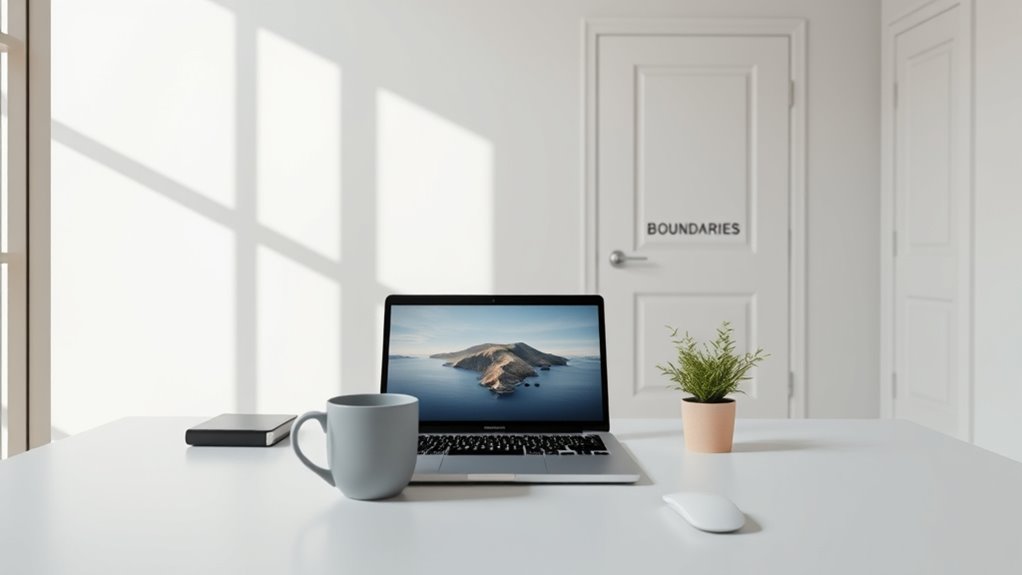
Organizing your digital space is only part of creating a healthier online environment; setting clear boundaries around your technology use is equally important. Limit your screen time to two hours or less outside of work, and designate tech-free times like during meals or an hour before bed. Schedule regular disconnect periods to be fully present and reduce mental fatigue. Keep work hours separate from personal time to prevent burnout, especially if working remotely. Use apps or device features like Screen Time to monitor and control your usage. Create device-free zones in your home, such as bedrooms or dining areas, to improve sleep and social interactions. Turn off non-essential notifications, and set specific times to check emails or social media. These boundaries help promote mental clarity and stronger relationships. Additionally, understanding potential pitfalls in adopting new payment technologies can help you better manage your online financial activities and avoid unnecessary risks. Being aware of special events and themed breakfasts in your community can also provide opportunities for social engagement and relaxation. Recognizing the importance of regulatory considerations in Bitcoin IRA investments can help ensure your digital assets are managed legally and securely. Incorporating mindful technology habits, like engaging in activities such as sound healing science, can further support your overall well-being and digital balance. Developing awareness of AI ethics and job roles can help you navigate the evolving tech landscape responsibly.
Reclaiming Time for Offline Activities
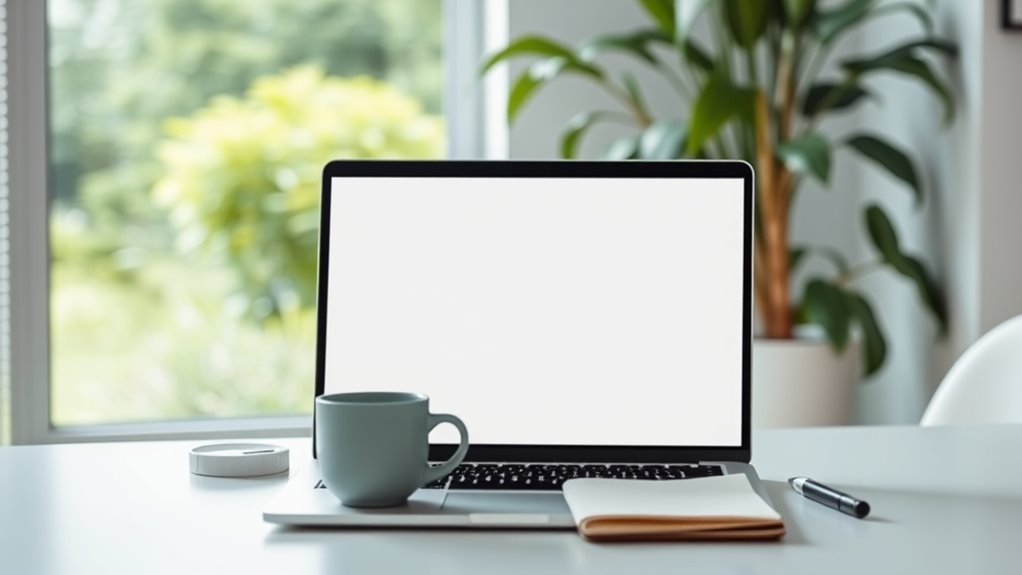
Have you ever noticed how much time slips away when you’re glued to screens? Cutting back on digital noise lets you focus on meaningful activities. You’ll find yourself engaging more in hobbies and passions you might’ve neglected. This shift boosts your creativity and sharpens your problem-solving skills by reducing digital distractions. You’ll also have more time for outdoor pursuits and physical activity, improving your overall well-being. As you declutter your digital life, your mind becomes clearer, with less cognitive overload. To do this, identify and eliminate low-value digital clutter, set digital-free zones, and monitor your screen time. Prioritizing high-value online interactions helps maintain balance. Additionally, understanding signs of digital clutter and overload can guide you in making effective changes. Recognizing archives of your digital activity can help you identify patterns and areas for improvement. For instance, using digital detox strategies can further reduce mental fatigue. Ultimately, reclaiming offline time enhances your mental clarity, boosts productivity, and nurtures your personal growth.
Enhancing Personal and Social Connections
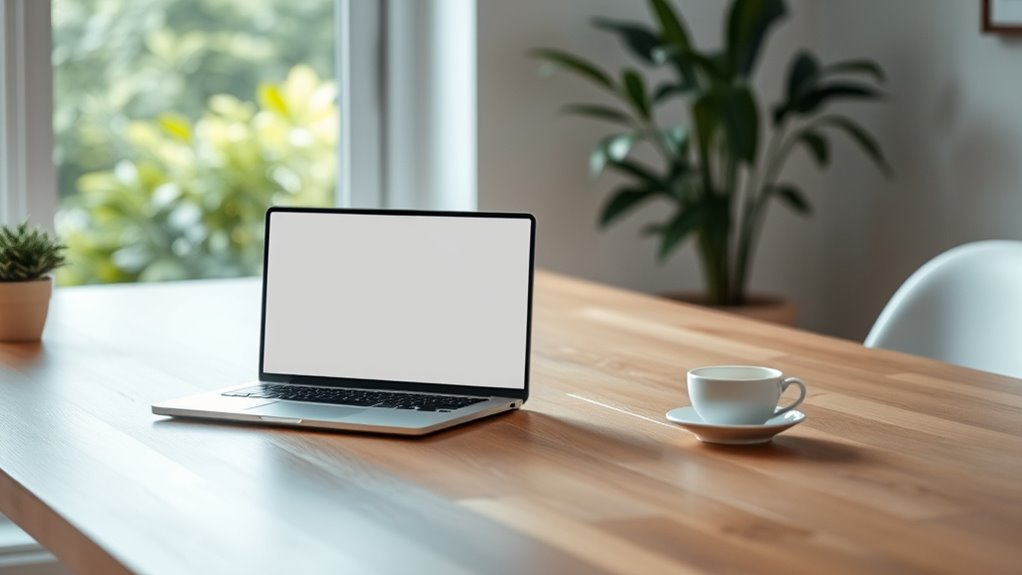
By intentionally shaping how you use technology, you can foster stronger personal and social connections. Focus on value-driven tools that genuinely enhance communication, and schedule specific times for checking emails or social media to avoid constant distractions. Set strict limits on non-essential apps to prevent compulsive habits. Consider using single-purpose devices, like e-readers, to minimize multi-app distractions during interactions. Regular tool audits help guarantee your digital habits align with relationship goals. Strengthen in-person bonds by establishing tech-free zones during meals or walks and replacing passive screen time with shared activities like cooking or hiking. Practice active listening, maintain eye contact, and prioritize face-to-face conversations for meaningful connections. These intentional steps deepen relationships and foster genuine social bonds in your digital life.
Protecting Your Privacy and Digital Security
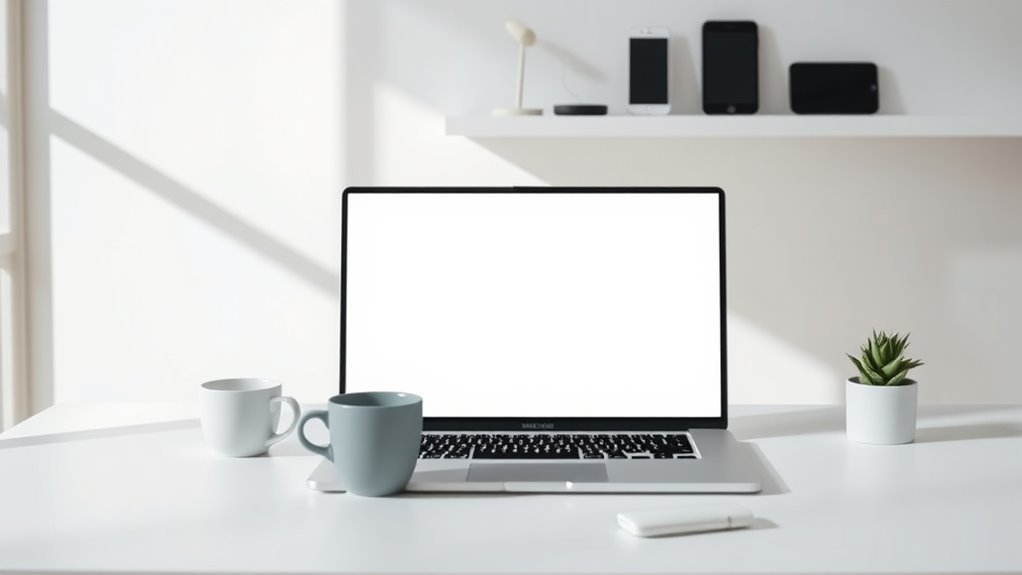
How can you effectively safeguard your digital life from threats and breaches? Start by using encryption tools like Microsoft BitLocker or Apple FileVault to protect your data at rest. Encrypt your emails and messages with protocols ensuring only you and your recipient can read them. Employ encrypted messaging apps with end-to-end encryption and keep your software updated to patch vulnerabilities. Use a VPN to create secure, encrypted tunnels, hiding your IP address and activity from prying eyes, but remember it doesn’t guarantee total anonymity. Choose privacy-focused browsers like Brave or Tor, and add tracker-blocking extensions. Manage your passwords with a reputable manager, enable multi-factor authentication, and review app permissions regularly. Finally, keep your devices and software current, and limit sharing personal info online to stay protected.
Maintaining Balance: Continuous Self-Assessment
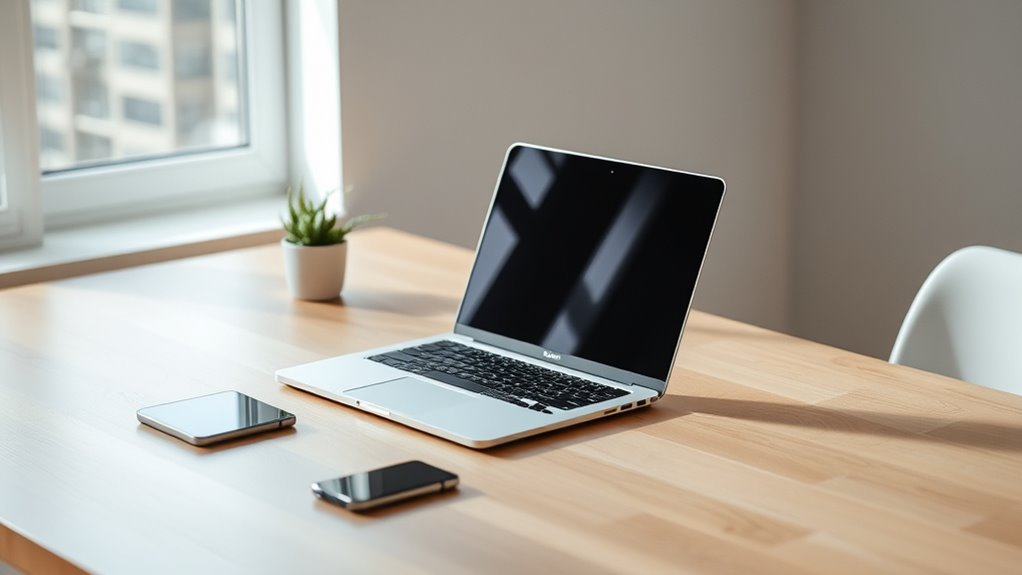
To maintain a healthy digital balance, regularly evaluating your current usage and its effects is essential. Track how much time you spend daily on devices and specific apps to identify patterns or excesses. Decide which activities serve your personal and professional goals and which are distractions. Reflect on how your technology use impacts your mental health, stress, focus, and sleep quality, especially before bed. Consider what offline experiences you’re missing due to online engagement. Set clear boundaries by establishing rules and designated no-device times. Periodically reassess your digital habits and adjust boundaries as needed. Use self-monitoring or accountability to stay on track. By continuously evaluating and refining your digital life, you ensure it supports your well-being and long-term objectives.
Frequently Asked Questions
How Can I Start Practicing Digital Minimalism Effectively?
To start practicing digital minimalism effectively, first identify what digital tools truly add value to your life. Unsubscribe from unnecessary emails and unfollow distracting social media accounts. Set specific time limits for your screen use and create boundaries around digital activities. Regularly detox by disconnecting, and prioritize offline hobbies and face-to-face interactions. By being intentional with your digital habits, you’ll reduce stress and boost your overall well-being.
What Digital Tools Best Support a Minimalist Lifestyle?
You want to know which digital tools best support a minimalist lifestyle. Focus on automation apps like IFTTT to handle repetitive tasks, and use minimalist email clients to reduce inbox clutter. Block distractions with focus apps, and schedule offline activities with integrated calendar tools. Limit social media and phone use with timers or silent modes. These tools help you stay intentional, reduce digital noise, and create more space for meaningful experiences.
How Do I Handle Social Media Detox Challenges?
Imagine steering a stormy sea, each wave representing a social media challenge. To handle detox struggles, set clear anchors—like limiting your use to 30 minutes daily and tracking habits. Seek support from friends or activities that ground you. Prepare by planning enjoyable alternatives. Remember, like weathering storms, patience and consistency help you stay afloat, eventually finding calmer waters and restoring your mental balance.
Can Digital Minimalism Improve My Mental Health Long-Term?
Yes, digital minimalism can improve your mental health long-term. By reducing digital overload, you’ll experience less anxiety and depression. It helps you focus on meaningful activities, boosts your self-awareness, and enhances emotional regulation. Over time, these habits promote better sleep, reduce digital fatigue, and foster offline connections. Staying intentional with your technology use can lead to sustained mental well-being and a more balanced, fulfilling life.
How Often Should I Reassess My Digital Habits?
Think of your digital habits as a garden that needs regular tending. You should reassess them every few weeks or when you notice stress, decreased face-to-face interactions, or changes in media use. Frequent check-ins help you spot weeds like overuse or anxiety triggers, allowing you to prune and adjust. This ongoing care keeps your digital life balanced, healthy, and aligned with your goals, ensuring long-term well-being.
Conclusion
By embracing digital minimalism, you’re planting seeds of clarity in a cluttered landscape, allowing your life to bloom with purpose and peace. As you prune your online habits, you’ll find your days brighter and your mind clearer—like a garden suddenly bathed in sunlight. Remember, this journey isn’t a one-time harvest but an ongoing tending. Keep nurturing your digital well-being, and watch your life flourish beyond the screen, vibrant and truly alive.
